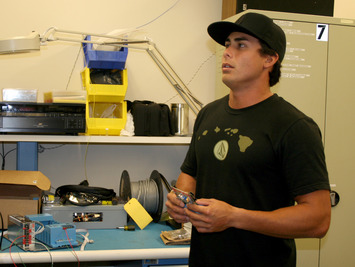
Born and raised in Kekaha, on the island of Kauai, Evan Agor is a UH Manoa alumnus with bachelor’s degrees in Business Management and International Business. He has returned to academia and is attending Kaua‘i Community College to study Electronics Technology. He plans on pursuing a bachelor’s in Electronics Technology Engineering and hopes to have a bright and prosperous future. Evan enjoys hobbies including surfing, fishing, soccer, and socializing with friends.
Home Island: Kauai
Institution when accepted: Kauai Community College
Akamai Project: The SMA Antenna Monitoring System: Access 24 Hours a Day
Project Site: Smithsonian Astrophysical Observatory
Mentor: Paul Yamaguchi
The Smithsonian Submillimeter Array (SMA) is an eight-element interferometric telescope that monitors submillimeter radiation from cold interstellar material. Its antennas house complex electronics that collect incoming signals from the sky, combine them with local oscillator signals, and generate intermediate-frequency signals. All of these signals are vital to successful antenna operation and sometimes experience technical difficulties. To fix problems with an antenna’s electronics, SMA staff must physically visit the antenna cabin to troubleshoot and manually diagnose the problem. A solution that reduces the need for on-site visits is the implementation of a remote Antenna Monitoring System (AMS). Located within the antenna cabin, the AMS is a Web-based system that exports the health and status of the receiver’s signals to remote locations. Via Internet, the AMS provides the ability to monitor 20 user-selected radio-frequency (RF) signals (13 predefined & 7 undefined) instantaneously, while at the same time generating RF spectra on a graphical user interface. By remotely examining the data delivered by the AMS, technicians can diagnose and perform the adjustments necessary for superior signal performance. My project was to build the third such AMS unit, to be installed on Antenna 7. Fabrication of the AMS was broken down into three phases. First, multiple circuit boards were constructed for the ADAM 5000, an Ethernet/hardware interface located within the AMS enclosure that permits signal selection. Next, the steel AMS enclosure was fabricated, the electronic components were installed, and the components were interconnected and verified. Finally, switch performance of the AMS using a host computer was tested using a Perl script. The completed AMS was then installed in Antenna 7 for testing and powered up to operating standards. Now, whether they are in the Mauna Kea summit control room, in the Hilo SMA offices, or at home, the AMS provides technicians with 24-hour access to monitoring antenna signals.